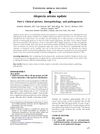TLDR Blocking CD44 can reduce leukocyte migration in autoimmune skin diseases.
The study investigated the role of CD44 in leukocyte migration in autoimmune diseases, specifically alopecia areata (AA) and chronic eczema. Researchers explored whether blocking CD44 could inhibit the migration of leukocytes, particularly AA effector cells, using CD44 isoform-specific antibodies. In vitro, anti-panCD44 and anti-CD44v10 antibodies inhibited leukocyte migration in both control and AA mice. In vivo, these antibodies interfered with T cell and monocyte extravasation into the skin, with anti-panCD44 also preventing T cell homing into lymph nodes. The study suggested that targeting AA T cells with a panCD44-CD49d-bispecific antibody could support allergen treatment in AA by selectively inhibiting T cell migration.
33 citations
,
October 2006 in “European Journal of Immunology” The CD44-CD49d complex boosts T cell activation and survival in autoimmune disease.
24 citations
,
May 2006 in “Journal of Investigative Dermatology” Chronic contact eczema may help hair regrowth in alopecia areata by reducing certain immune cell movement.
 185 citations
,
August 2005 in “Autoimmunity Reviews”
185 citations
,
August 2005 in “Autoimmunity Reviews” Alopecia areata is an autoimmune condition causing hair loss due to the immune system attacking hair follicles, often influenced by genetics and stress.
20 citations
,
February 2004 in “Clinical & Experimental Immunology” SADBE treatment led to complete hair regrowth in mice with alopecia areata by altering immune cell movement.
48 citations
,
June 2003 in “Journal of Investigative Dermatology Symposium Proceedings” Contact sensitizers like DCP and SADBE are the most effective treatments for alopecia areata.
 131 citations
,
November 1998 in “The journal of investigative dermatology/Journal of investigative dermatology”
131 citations
,
November 1998 in “The journal of investigative dermatology/Journal of investigative dermatology” Skin grafts on mice can cause an immune response leading to hair loss, useful for studying human hair loss conditions.
24 citations
,
May 2006 in “Journal of Investigative Dermatology” Chronic contact eczema may help hair regrowth in alopecia areata by reducing certain immune cell movement.
 391 citations
,
January 2010 in “Journal of The American Academy of Dermatology”
391 citations
,
January 2010 in “Journal of The American Academy of Dermatology” Half of people with Alopecia Areata may see hair regrowth within a year without treatment, but recovery is unpredictable.
20 citations
,
February 2004 in “Clinical & Experimental Immunology” SADBE treatment led to complete hair regrowth in mice with alopecia areata by altering immune cell movement.

Alopecia areata is an autoimmune disease affecting hair follicles and may harm heart health.
45 citations
,
June 2018 in “Frontiers in immunology” MDSC-Exo can treat autoimmune alopecia areata and promote hair regrowth in mice.



